

Finnish emissions
To study the situation in one Arctic country in more detail the Finnish emissions were calculated with high spatial resolution.
For the case of Finland, the reference scenarios base on the National Energy and Climate Strategy 2013 update. The black carbon mitigation scenario was designed in this project to study emission reduction potential especially in the residential wood combustion sector.
The Finnish scenarios were as follows:
- Finnish reference scenario with climate measures (CLE) fulfills the agreed EU targets for CO2 reduction, renewable energy and energy efficiency
- Finnish With-Additional-Measures reference scenario (WAM) additionally includes measures(*) to reach the non-ETS (Emission Trading Scheme) sector goal (-16%) and better anticipates 80% reduction by 2050
- Finnish mitigation scenario with measures to reduce black carbon emissions in the residential wood combustion sector (BCres)
(*) The additional measures mainly concern transport (traffic mode changes and ”eco-driving”), residential (stricter building energy regulation) and energy production sectors (less fossil fuel use from 2020 onwards).
Finnish emissions in the reference scenarios
Current climate and air pollution policies and legislation in the reference scenario (CLE) considerably reduce the emissions of black carbon (BC), organic carbon (OC) and sulphur dioxide (SO2) by 2020 and 2030 (Fig. 1, 2 and 3). Reductions of BC and OC are mainly due to stricter emission legislation in the transport sector, the so-called EURO emission limit values set for new vehicles (Fig. 4 and 5). For sulphur dioxide (SO2) emissions, biggest reductions are expected in the Energy production and industrial combustion sector (Fig. 6).
The additional climate related measures in the WAM scenario reduce the emissions of BC and OC by 15% and 9%, respectively, in 2030 compared to CLE scenario due to less heating need in the residential sector and less fuel consumption in the transport sector. The emissions of SO2 decrease 10% due to less fossil fuel use.
Mitigation opportunities in residential wood combustion sector
The mitigation scenario BCres demonstrates possibilities to reduce black carbon emissions in the residential wood combustion sector. The reduction potential was estimated at 1.8 Gg(BC)/a, or 61% of the total BC emissions compared to WAM scenario in 2030. Due to the same measures the emissions of OC decrease by 1.4 Gg(OC)/a, or 43% of the total.
The biggest additional reductions were estimated for accelerated installation of cleaner stove technologies (0.82 Gg(BC)/a) and introduction of end-of-pipe technologies 0.66 Gg(BC)/a (Fig. 7). The biggest potential in clean stove technologies occurs on sauna stoves, 0.73 Gg(BC)/a. Sauna stoves are not included in the EU EcoDesign directive but they have relatively high emissions. The launch of clean sauna stove technologies into the market could be promoted by national legislation.
The introduction of end-of-pipe technologies assumed here the installation of electrostatic precipitators (ESP) to the whole stove and boiler stock. ESPs and other end-of-pipe technologies are relatively expensive and do not appear very cost-efficient measures to mitigate black carbon emissions at the moment. These technologies, however, are still only at the early phases of commercialization, and therefore their costs and technical performance are expected to improve in the future.
Spatial distribution of Finnish emissions
The emissions can be observed at high spatial resolution inside Finland. Different source sectors have different spatial distribution of emissions. Residential wood combustion emissions are relatively evenly distributed over the inhabited parts of Finland (Fig. 8). The highest emission densities occur in the sub-urban areas of the biggest cities in southern parts of the country, with considerable emissions also in less urbanized central Finland.
Road traffic emissions are more concentrated to urban areas and along major highways in southern Finland (Fig. 9). Off-road traffic and machinery occur to great extent also in urban areas, with machinery used in agriculture and forestry in less inhabited areas. The differences in the urban/rural weighted emissions have relevance especially from health point of view. The south-north differences, i.e. the vicinity of emissions to Arctic areas, are relevant also from climate perspective.
Related information
National Energy and Climate Strategy 2008 (Ministry of Employment and Economy)
Update of the National Energy and Climate Strategy 2013 (Ministry of Employment and Economy)
Emission figures
Click the figures to enlarge
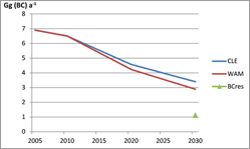
Fig 1. Finnish emissions of black carbon in 2005-2030 by scenario
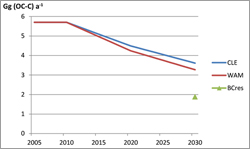
Fig 2. Finnish emissions of organic carbon in 2005-2030 by scenario
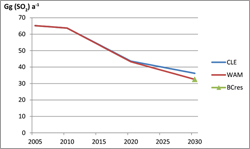
Fig 3. Finnish emissions of sulphur dioxide in 2005-2030 by scenario
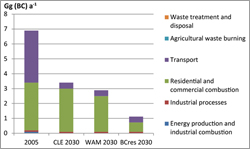
Fig 4. Finnish emissions of black carbon in 2005 and 2030 by sector in reference (CLE and WAM) and mitigation (BCres) scenarios

Fig 5. Finnish emissions of organic carbon in 2005 and 2030 by sector in reference (CLE and WAM) and mitigation (BCres) scenarios
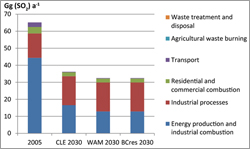
Fig 6. Finnish emissions of sulphur dioxide in 2005 and 2030 by sector in reference (CLE and WAM) and mitigation (BCres) scenarios
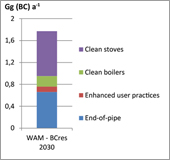
Fig 7. Black carbon emission mitigation potential by mitigation measures in BCdom scenario in 2030
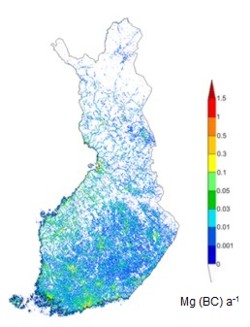
Fig 8. Spatial distribution of Finnish black carbon emissions in residential wood combustion sector in 2005
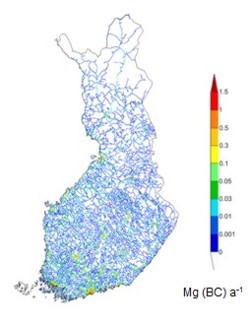
Fig 9. Spatial distribution of Finnish black carbon emissions in road transportation sector in 2005
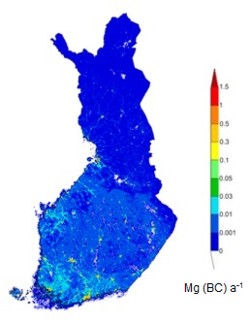
Fig 10. Spatial distribution of Finnish black carbon emissions in other land transportation and machinery sector in 2005
